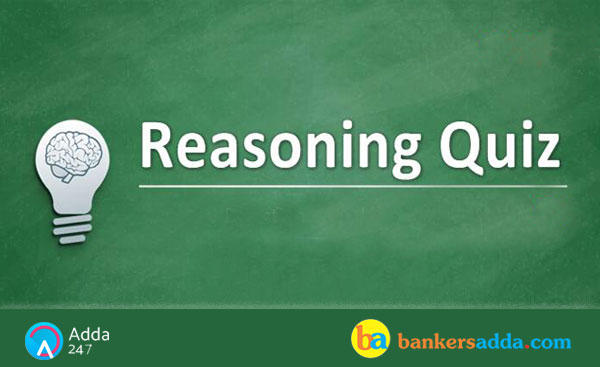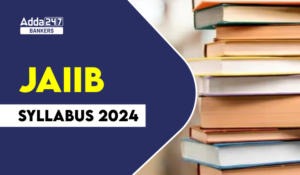Dear Aspirants,
Reasoning Ability is an onerous section. With the increasing complexity of questions, it becomes hard for one to give it the cold shoulder. The only way to make the grade in this particular section in the forthcoming banking exams is to practice continuously with all your heart and soul. And, to let you practice with the best of the latest pattern questions, here is the Adda247 Reasoning Quiz based on the exact same pattern of questions that are being asked in the exams.
Directions (1-5): Study the information and answer the given questions:
There are seven boxes viz. A, B, C, D, E, F and G. All the box are of different colour viz. Red, black, blue, yellow, cream, violet and orange but not necessarily in the same order. All the box are arranged from top to bottom.
Box D is immediately above the yellow colour box. More than three boxes between cream colour box and orange colour box. There are two boxes between the box B and box E, which is of red colour. There is only one box between box E and box G. There is three box between box G and box A, which is of black colour. There are two boxes between box A and box C, which is of violet colour. The orange colour box is immediately above the box G. More than three boxes between the yellow colour box and the cream colour box.
Q1. Which of the following box is at the top?
(a) A
(b) B
(c) C
(d) D
(e) E
Q2. What is the colour of box B ?
(a) violet
(b) black
(c) blue
(d) cream
(e) orange
Q3. Which of the following is yellow colour box ?
(a) D
(b)E
(c) F
(d) G
(e) A
Q4. How many box/es is/are there between D and the box which is of blue colour?
(a) Four
(b) Three
(c) Two
(d) One
(e) No one.
Q5. If B is related to blue colour box and E is related to yellow colour box in certain way, then A is related to ?
(a) orange colour box
(b) violet colour box
(c) yellow colour box
(d) cream colour box
(e) None of these
Directions (6-10): In each of the questions below is given four statements followed by four conclusions numbered I, II, III . You have to take the given statements to be true even if they seem to be at variance with commonly known facts. Read all the conclusions and then decide which of the given conclusions logically follows from the given statements disregarding commonly known facts.
Q6. Statements:
Some light is star.
All star is pen.
No pen is sun.
Some sun is moon.
Conclusions:
I. Some star is not sun.
II. All star being sun is a possibility.
III. All star being pen is a possibility.
(a) Only I follow
(b) Only III follow
(c) Only II and III follow
(d) All I, II and III follow
(e) None of these
Q7. Statements:
All chair is paint.
No chair is page.
Some page is red.
All red is blue.
Conclusions:
I. Some paint is red.
II. No page is paint.
III. All red being blue is a possibility.
(a) Only I and II follow
(b) Only II and III follow
(c) Only I and III follow
(d) None follow
(e) Either I or II follow
Q8. Statements:
All tea is coffee.
All coffee is drink.
No coffee is milk.
All milk is water.
Conclusions:
I. All coffee being tea is a possibility.
II. All tea being drink is a possibility.
III. Some water is not tea.
(a) None follows
(b) Only I follows
(c) Only II follows
(d) Only I and III follows
(e) Only II and III follow
Q9. Statements:
No mouse is rat.
Some rat is cow.
All cow is deer.
No deer is dog.
Conclusions:
I. Some rat is not dog.
II. No dog is cow.
III. No mouse is dog.
(a) None follows
(b) Only I follows
(c) Only I and II follows
(d) Only I and III follows
(e) Only II and III follow
Q10. Statements:
Some noida is agra.
All agra is meerut.
All noida is kanpur.
No noida is pune.
Conclusions:
I. Some meerut is pune.
II. All kanpur being pune is a possibility.
III. All noida being kanpur is a possibility.
(a) None follows
(b) Only I follows
(c) Only II follows
(d) Only III follows
(e) Only II and III follow
Directions (11-12): In the given questions, assuming the given statements to be true. Find which of the given four conclusions numbered I, II, III and IV is/are definitely true and give your answer accordingly.
Q11. Statement: M > U > L ≤ N; L ≥ Y > A
Conclusions:
I. M ≥ Y
II. M > N
III. N ≥Y
IV. M ≥ A
(a) Only either II or III is true.
(b) Only IV and either I or III are true.
(c) Only IV is true.
(d) Only II is true.
(e) Only III is true.
Q12. Statement: J ≥ A > D = E; L < A < M
Conclusions:
I. M < J
II. J ≥ L
III. M≥ J
IV. E >M
(a) Only II is true.
(b) Only I and III are true.
(c) None is true.
(d) Only II and IV are true.
(e) Only I and II are true.
Directions: (13-15): In the following questions, the symbols @, $, #, © and % are used with the following meaning as illustrated below.
‘P $ Q’ means ‘P is not smaller than Q’.
‘P © Q’ means ‘P is neither greater than nor equal to Q’.
‘P # Q’ means ‘P is neither smaller than nor equal to Q’.
‘P % Q’ means ‘P is not greater than Q’.
‘P @ Q’ means ‘P is neither greater than nor smaller than Q’.
Now, in each of the following questions, assuming the given statements to be true, find which of the four conclusions I, II, III and IV given below them is/are definitely true and give your answer accordingly.
Q13. Statements: R # J, J $ D, D @ K, K % T
Conclusions:
I. T # D
II. T @ D
III. R # K
IV. J $ T
(a) Only either I or II is true
(b) Only III is true
(c) Only III and IV are true
(d) Only either I or II and III are true
(e) None of these
Q14. Statements: T % R, R $ M, M @ D, D © H
Conclusions:
I. D % R
II. H # R
III. T © M
IV. T % D
(a) Only I is true
(b) Only I and IV are true
(c) Only I and III are true
(d) Only II and IV are true
(e) None of these
Q15. Statements: M @ B, B # N, N $ R, R © K
Conclusions:
I. K # B
II. R © B
III. M $ R
IV. N © M
(a) Only I and III are true
(b) Only I and II are true
(c) Only II and IV are true
(d) Only II, III and IV are true
(e) None of these
You May also like to Read:
- More questions on Reasoning for Bank exam
- Reasoning ability study notes and tips
- SBI Clerk Mock Tests 2018



 The Hindu Review October 2022: Download ...
The Hindu Review October 2022: Download ...
 JAIIB Syllabus & Exam Pattern 2024, ...
JAIIB Syllabus & Exam Pattern 2024, ...
 Daily Current Affairs 26th April 2024, I...
Daily Current Affairs 26th April 2024, I...



